Review: Livid Base
Hot on the heels of Ableton’s Push controller (which we reviewed back in April) comes […]

Hot on the heels of Ableton’s Push controller (which we reviewed back in April) comes Livid Instruments‘ Base, the newest design from the boutique, Austin-based shop. Push provides a rather interesting point of comparison: The two pieces of hardware have much in common physically, while the underlying philosophy has anything but. Where Push was designed to work in a particular way with a specific piece of software, Base is largely what you make of it, a more generic blank slate that’s willing to accommodate a host of varied approaches.
How It Looks
Dressed up in all matte black with grids of RGB LED buttons, Base and Push look like they come from the same gene pool at first glance. This correspondence is more than skin deep, too, as Base feels exceptionally sturdy in much the same way as its German counterpart, perhaps even more so; housed in a solid aluminum chassis, the machine has a weight and solidity to it that inspires confidence and sets it firmly into the higher-end of MIDI-gear construction. The top of the unit is lined with rubberized plastic, which frames the 32 drum pads, nine ribbon controllers, and eight smaller function buttons—with metal siding and no moving parts whatsoever, it feels extremely durable. The matte finish is fingerprint-proof, and, overall, the care and quality of Livid’s handiwork is evident (like all Livid controllers, Base is built at Livid’s factory in Austin).
How It Works
The pads feel great (and quite similar to Push’s pads), but what makes Base special—beyond its design and build sensibilities—is the ability to combine control of the pressure-sensitive buttons with the responsive ribbon controllers. The immediacy of playing these touch strips as faders and filters feels significantly different from doing so with standard sliders, and the embedded LEDs within each make sure that the communication flows in both directions (this is aided by the touch buttons above each of the main eight ribbon controllers, which have embedded LEDs as well). These vertical, virtual faders can send note-on and -off values (with velocity), allowing for quite unique forms of musical expression.
The Livid mapping software is relatively straightforward, and setting up Base as something tailored to a specific workflow is easy enough. In order to get Base up and running as quickly as possible with, say, Ableton, there are presets that allow you to do so: The bank buttons switch the pad functionality between drums, clip triggering, and instruments, while the faders easily swap between mix, sends, and device parameter controllers.
The Bottom Line
Livid hasn’t reinvented the wheel here. Rather, they’ve made an expressive, finely crafted, flexible instrument that will play nicely with any software currently on the market. It’s yet another variation on the grid-style MIDI controller, and in this sense, has plenty of competition; between Push, Maschine, monome, Launchpad, and now Base (among many others), this sort of devices now comes in an incredible variety of shapes and sizes. Now, the only tricky part for producers will be finding the right one to match with their own unique creative process.
MSRP: $399

